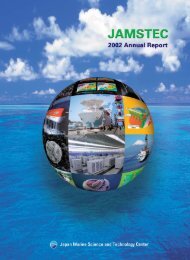2007 Annual Report - jamstec japan agency for marine-earth ...
2007 Annual Report - jamstec japan agency for marine-earth ...
2007 Annual Report - jamstec japan agency for marine-earth ...
You also want an ePaper? Increase the reach of your titles
YUMPU automatically turns print PDFs into web optimized ePapers that Google loves.
"Global comparison of zooplankton time-series" and developed<br />
a series of statistical methods <strong>for</strong> the effective regional comparison<br />
of ecosystem changes. The Working Group plans to hold a<br />
special session on this topic during the International symposium<br />
"Effects of Climate Change on the World's Oceans" in May<br />
2008, and publish a special issue of a scientific journal to present<br />
the accomplishments of the working group activities.<br />
We also conducted the study on the Pan-North Pacific<br />
comparison of zooplankton time-series based on the stable isotope<br />
ratio of the major zooplankton species, Neocalanus spp.<br />
collected in the western, central and eastern North Pacific during<br />
1960s - 2005 under the collaboration of domestic and international<br />
organizations. From the interannual variation of<br />
Nitrogen stable isotope of Neocalanus, we found the bottom-up<br />
control of food web structures, which might be derived from<br />
temporal variation in environmental conditions of the respective<br />
regions. This study was funded by the Grant-in-Aid <strong>for</strong><br />
Scientific Research.<br />
b-2. Comparative study of long-term changes in terrestrial and<br />
<strong>marine</strong> ecosystems<br />
We analyzed stable isotope ratio of Salmonid fish scales<br />
taken in the Lake Baikal and western North Pacific <strong>for</strong> the past<br />
50 years. We found the quasi-bi-decadal synchrony in the stable<br />
isotope ratio of the fish, which inhabited in the completely<br />
remote and independent ecosystems each other. This result suggested<br />
that dynamics of the Okhotsk High and Aleutian Low<br />
might influence the atmospheric and hydrographic conditions of<br />
Siberia and North Pacific at the same timing in decadal scale.<br />
b-3. Analysis of seasonal and interannual variability of chlorophyll<br />
a and primary productivity using satellite data<br />
We made a classification map in the North Pacific including<br />
some marginal Sea Japan Sea, Okhotsk Sea and Bering<br />
Sea based on magnitude of seasonal change standard deviation<br />
and peak chl-a values during spring bloom using 11-<br />
years' ocean color satellite data , and examined relationships<br />
between chl-a concentrations and sea surface temperature<br />
anomalies at each regions . The results show warmer sea surface<br />
temperature corresponds to higher chl-a concentrations in<br />
the Bering Sea and Oyashio regions. Contrastively, opposite<br />
patterns were seen in Gulf of Alaska and Kuroshio regions. In<br />
FY2008, we will examine those mechanisms in detail and discuss<br />
the relation to climate change. As part of same research<br />
using ocean color data, interannual variability of spring bloom<br />
timing in the North Pacific was investigated. The results show<br />
timing of spring blooms in northwestern and adjacent sea<br />
around marginal sea region was earlier in El-Niño year<br />
Warmer phase and later in La-Nina year Cooler phase.<br />
On the other hand, opposite pattern was seen in offshore southeastern<br />
region.Our two major research topics suggest that<br />
oceanic environment or <strong>marine</strong> ecosystem response to climatic<br />
<strong>for</strong>cing is different from each regions.<br />
b-4. Development of pCO 2 model using satellite data<br />
A model to estimate the partial pressure of carbon dioxide<br />
pCO 2 <strong>for</strong> the North Pacific was developed using satellite<br />
data last year In cooperation with Nagoya University. The<br />
model derived pCO 2 results showed good agreement with shipboard<br />
data within an error of 15-18 micro-atm. This method<br />
suggests that it is possible to evaluate basin-scale pCO 2 trends<br />
using remote sensing data. However, we cannot describe seasonal,<br />
interannual variations and effects due to climate change<br />
such as El-Niño and La-Nina events in detail. Now first version<br />
of global algorithms was completed.<br />
c. Modelling of interannual variability of <strong>marine</strong> ecosystem and<br />
International collaboration<br />
Using a global 3-dimensional <strong>marine</strong> ecosystem model<br />
COCO-NEMURO combined with carbon cycle based on the<br />
Fig.3 Left bottom: Time-series of nitrogen isotope ratio in the<br />
scales of Ormul in Lake Baikal and pink salmon in the western North<br />
Pacific the long-term trend is removed.<br />
Right:Long-term variability of anomalous westerly velocities over the<br />
Siberia and western North Pacific.<br />
OCMIP Ocean Carbon-cycle Model Intercomparison<br />
Project protocol, we have investigated the impact of climate<br />
variability in the North Pacific such as the Pacific Decadal
















